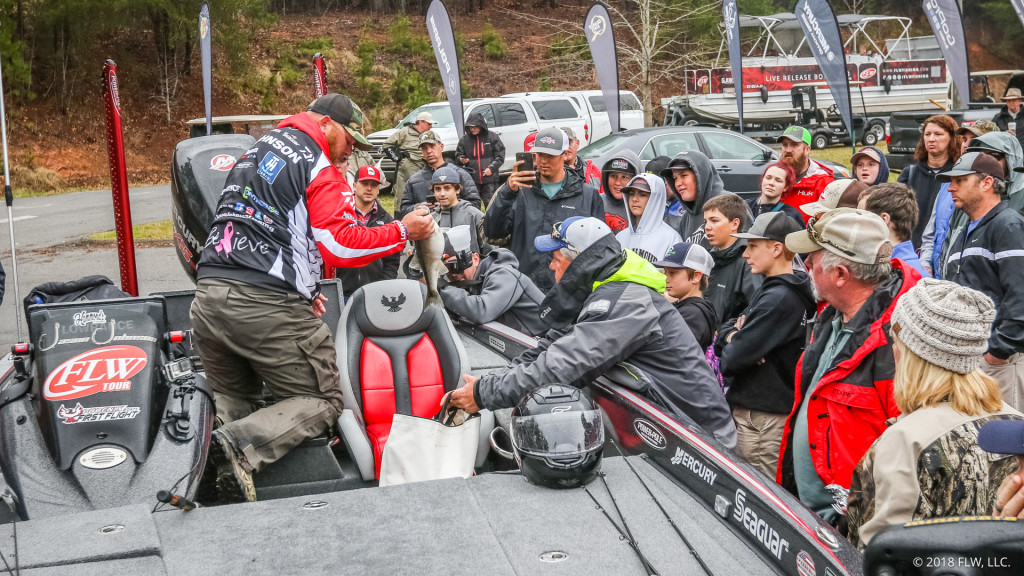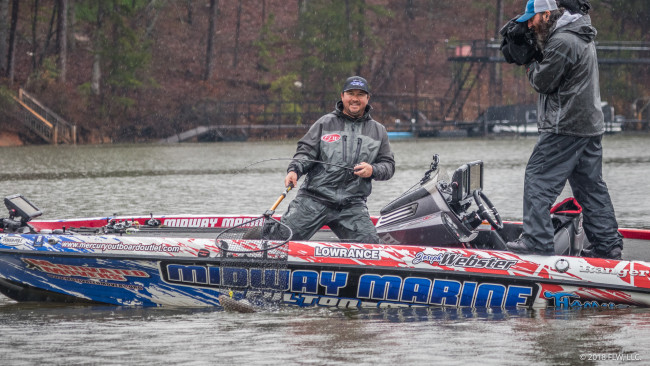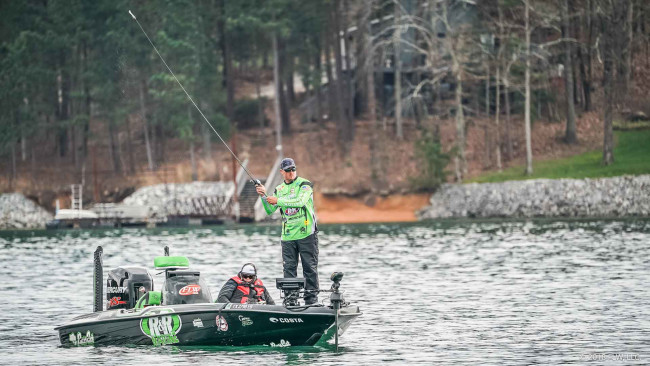Top 10 patterns from Lake Lanier
Georgia’s Lake Lanier is one of the best spotted bass fisheries in the Southeast

If there was any debate, it was answered this week: Georgia’s Lake Lanier is one of the best spotted bass fisheries in the Southeast.
Pro after pro came across the weigh-in stage this week at the FLW Tour event presented by Ranger on Lake Lanier gushing about the quality of the spots. Numerous pros said they’d broken their personal bests multiple times since arriving, while others said they didn’t even bother fishing for largemouths; the spots were heavier and more plentiful. And the thing is, the conditions were a roller coaster throughout practice and the tournament. One could only imagine what might have been had conditions been ideal.
Those changing conditions often left anglers scrambling or scratching their heads, with the top 10 pros having to adjust plans regardless if they were in the clear water below Brown’s Bridge or the stained waters of the rivers.
2. Birge rides six points to near victory
Zack Birge checked hundreds of points throughout practice. Of them, six seemed to consistently produce fish, and they didn’t stop during the event.
While he tried expanding down into the lower end and even hitting docks from time to time, Birge stayed primarily on a half dozen points located mid-lake between Brown’s Bridge and about where the two rivers meet. Most were off islands, and all had a bit more rock than most, but the main distinguishing characteristic was depth. They were shallower than others – topping out at 8 to 15 feet.
“I just always caught a fish every time I checked them,” says the Blanchard, Okla., pro. “So I just kept rotating through them all tournament. Each day was different, though. I caught a ton of fish the first two days. Then I only got six bites Saturday.”
On Sunday, a key color switch on his YUM 4.5 Pulse swimbait, from Tennessee Shad to a different one, seemed to turn the tides, as soon after he caught a 4-pound spot and a 5 1/4-pounder on the next point to help nearly catch Hallman. Unfortunately, the flurry was short-lived, and Birge never upgraded after filling his limit.
Birge rigged the swimbait on a 1/4-ounce ball-head jig, casting it out across the point, letting it hit bottom and then reeling it slowly back.
“I was basically dragging it with how slow I was reeling it, just letting it tick across the bottom,” says Brige. “I caught a couple on a shaky head, but the majority came on that swimbait.”

3. Webster stays upriver
Joseph Webster had plans to catch both spotted bass and largemouths. Only, Lanier’s spots had other plans.
Fishing close to takeoff, the Winfield, Ala., pro spent the first two days targeting spotted bass on little rock piles in 6 to 8 feet of water he found while idling around in practice.
“I think the spots are spawning on it,” says Webster, who caught his fish on a drop-shot, shaky head and Norman Deep Little N. “When you catch one, its tail is jacked up and belly orange from sitting on clay.”
Webster sacked up a consistent 16-7 and 16-6 the first two days, going through 25 keepers a day. On day three it was much of the same, but he wasn’t getting over the 13-pound mark no matter how many spots he caught.
To try and bump up his bag, he decided to fish for largemouths in the far backs of pockets around emergent dogfennel.
“There’s no rhyme or reason, but there were some good spots as far back in those weeds as you could get,” Webster says. “I was catching them on a 3/4-ounce spinnerbait.”
He targeted both species again on Sunday, but once again the spots proved to be more willing.

4. Johnson’s “best four days” not enough
Fishing a tournament on your home lake can either help or hurt you. It did both for Jason Johnson.
On one hand, Johnson says this tournament was the best four days in a row of fishing he’s ever had, tournament-wise. Fishing below Brown’s Bridge, he targeted isolated areas with the right mixture of cover and structure that spotted bass like to stage on before spawning.
“They’re places the herring filter through where the bass can eat them while they’re staging,” says Johnson. “[The places have to have] a little bit of sand, little bit of rock, some natural timber close by they can hold up on. It has to have a mixture of four or five elements.”
One particular spot Johnson knew as a big-fish spot from years past, and it produced a 5-9 and 4-9 the first day, and a 5-6 the second day. Unfortunately, it didn’t produce the third day, and it held him back on the final day.
“I couldn’t get away from the areas I know where big ones live,” says Johnson. “I knew I needed a big bag, and I couldn’t leave those spots.”
Regardless of the place, Johnson relied on a weightless green pumpkin or natural shad-colored Zoom Fluke Stick to catch suspended fish and the same Fluke Stick on a 1/2-ounce Carolina rig.
“It’s painfully slow fishing [the weightless Fluke Stick],” says Johnson. “I’d throw it out there, shake the rod, bring it back up and let it sink again, bring it back up and let it sink again. Those suspended fish are sitting 15 to 20 feet off the bottom. So once it goes through them I let it fall again.”

5. Setzer plays video games on sides of points
Braxton Setzer was pretty dialed in during practice, but a key adjustment is what got him into the top 10.
During practice, Setzer found plenty of fish on long-running points in the lower end of the lake. Yet come Thursday, those fish seemed to disappear. That is, until he eased around the side of one.
“I think the fishing pressure pushed them off the sides,” Setzer says. “That’s where I relocated them.”
Knowing where they were sitting, Setzer slowly eased around any point, tossing a Ned rig with a Nichols Clent's Toadstool Jig Head up on top. He also caught some Saturday on a Duel Hardcore jerkbait in pro blue.
The reason for the slow-go with the boat was to try not to spook any groups of fish, as many pros mentioned the spotted bass would scatter at times when a boat was overhead. If he saw any, Setzer did some “video game" fishing, dropping the Ned rig or even a wacky-rigged Yamamoto Senko to them and watching the lure and fish on his graph.
“If they weren’t too deep I’d use the wacky rig,” Setzer says. “The water was so clear, they’d come up and get it. But the majority of my fish came on the Ned rig in 25 to 35 feet.”
While Setzer says the weather never seemed to bother him or his fish, his bites went down every day of the event despite constantly running new areas. He did have 10 to 12 go-to places he would check every day, though.

6. Meyer top 10s again at Lanier
If there was one non-local who was a favorite going into this event, it was Cody Meyer. He didn’t disappoint.
Known as a giant spotted bass expert out in California, Meyer had finished second and 11th in two previous events at Lanier. Yet, while he notched another top 10, this one was a bit different in his approach.
“Rock was key,” says Meyer, who was fishing near the dam. “In practice I idled around a lot and found rock. Usually when you come to Lanier it’s brush piles, but they’re not really in brush right now. So anywhere I found offshore rock it seems like it was really good.”
Meyer’s deep rocks changed throughout the week, as his fish were sitting in 10 to 15 feet on day one and had moved to 25 to 30 feet as the tournament went on.
Regardless of depth, Meyer would pull up on a point and make a couple casts with a 3 3/4-inch Strike King Rage Swimmer on a 1/4-ounce Owner ball-head jig to see if there were any aggressive takers. He’d then move up on top of the structure. If he saw any he’d drop down vertically with a Strike King KVD Fat Baby Finesse Worm in green pumpkin blue on a shaky head or a drop-shot with a 4 1/4-inch Strike King KVD Dream Shot on a 1/4-ounce Strike King tungsten weight.
The plan worked perfectly all four days, as he caught 20 to 30 fish a day.
“The problem was, the first two days I caught 3-pounders,” Meyer says. “On Saturday, I caught two good ones and then nothing but 2-pounders. I caught more fish than I did all week, but the size was different. Same thing [on Sunday].”

7. Gussy channels brown-fish knowledge for consecutive top 10s
There aren’t any spotted bass up in Ontario, but there are plenty of bass just like them – smallmouths. Both Jeff Gustafson and fellow northerner Austin Felix says the two species are eerily similar, being aggressive, visual feeders. That knowledge of the spot's cousin helped both make the top 10, with Gustafson making it two in a row.
The man known as “Gussy” put his knowledge to use “about as far south” as he could go, often fishing within sight of the dam. There he fished dozens of points, often running new ones every day.
“There are fish it seems on every point,” says Gustafson. “I’m seeing about 500 fish a day on my graphs, but the best areas the fish are relating to have brush. They don’t have to be right in it, but it’s funny, usually they’re within 20 to 30 feet of it.”
The key depth seemed to be 28 to 30 feet, where he’d either pitch a new Jackall Ned Rig worm called the Dew Worm on a 1/5-ounce head ahead of the boat, or he’d vertically drop down a nail-weighted 5-inch Northland Tackle Dipstick to ones he could see on the graph.
The two-bait pattern worked best when the fish were closer to the bottom like they were on Saturday with less wind. The high winds on Friday and clouds Sunday made it much tougher to catch them.
“The ones that are easiest to catch were 4 to 5 feet off bottom,” says Gustafson.
“Here’s the deal; at home when fishing for smallmouth, we’ll hang baits above them. If you drop baits past them they don’t like that. These spots are the opposite. They don’t like when you hang baits over their heads. You have to let it fall past them to the bottom. Then if they follow it to the bottom it’s game over.”

8. Williams’ largemouth bite fizzles
Lanier’s spotted bass were the focus for most, but make no mistake about it, David Williams’ main target were largemouths.
He sacked up 18-7 one day one with a pair of giant largemouth kickers, and he caught another 16-6 Friday thanks to a late 5-pound largemouth. Unfortunately, despite what should’ve been improving conditions for his shallow pattern, his bite died. On day three the only largemouth he caught was a non-keeper, ironically while he was fishing for spots, and he scrapped the plan altogether on Sunday when a chance encounter happened.
“My plan was the same as before: catch a quick limit of spots and then chase largemouths,” says Williams. “The first pocket I pulled into these giant spots started schooling nearby. I couldn’t pull myself away from them. It was just too much fun catching them all day. It was just 3-pounder after 3-pounder.”
The schoolers aside, Williams spent every morning chasing spots inside one of the marinas just before you get to the lower end. He tossed a MegaBass Vision 110 jerkbait along riprap walls, and then pitched a Queen Tackle Hammerhead jig with a Zoom Z Craw trailer under walkways.
From there he began hitting shallow pockets with dogfennel, targeting largemouths, and throwing various spinnerbaits made by his father.

9. Osborne makes first top 10
After day one, Jordan Osborne was simply looking to collect a check. Turns out he had to stick around a few days longer.
“This was my first time fishing on Sunday,” Osborne says. “I liked it, and I’d like to do it some more.”
Osborne’s tournament turned around on Friday. Like many others, he was running-and-gunning points in 5 to 30 feet of water in the lower end and just above Brown’s Bridge. His weapon of choice was a hasu or electric shad Keitech 3.3 Swing Impact FAT on a 1/4-ounce ball-head jig. he crawled the combo along bottom.
On Thursday he caught 10 fish, but on Friday he caught 40, which turned into an 18-pound, 11-ounce bag. But he wasn't able to keep that pace on the weekend, and isn't sure why.
Regardless, a big thing for Osborne was what he felt while crawling his swimbait.
“When I pulled up on a new point, if I threw out and the bottom felt mushy, I left,” says Osborne. “It had to have some pebble, pea gravel, chunk rock; my jig had to go tick, tick, tick.”

10. Felix runs shallow-deep pattern despite conditions
Like his Northern counterpart, Jeff Gustafson, Austin Felix loves spots for their similarity to the smallmouths he chases in Minnesota.
Unlike Gussy, though, Felix had a two-pronged approach throughout the week.
He started the tournament on a schooling spot where herring were holding in a ditch in a creek arm. He sacked up a quick limit there by swimming a Keitech Swing Impact on a 1/4-ounce head. Then he crawled the swimbait and a shaky head on bottom on structures 30 to 40 feet deep.
Unfortunately, the cold night between days one and two hurt his pattern.
“All the baitfish left my shallow area,” Felix says. “I had to scramble most of Friday, but I was able to relocate the bigger fish late and sack them up.”
While he was able to adjust on day two, Felix says the changing conditions continued to wreak havoc on his patterns as his weight slipped on day three, and he was only able to bring in four bass the final day.
